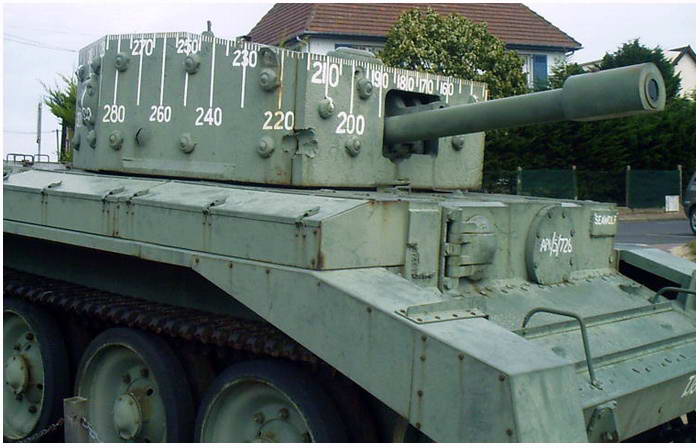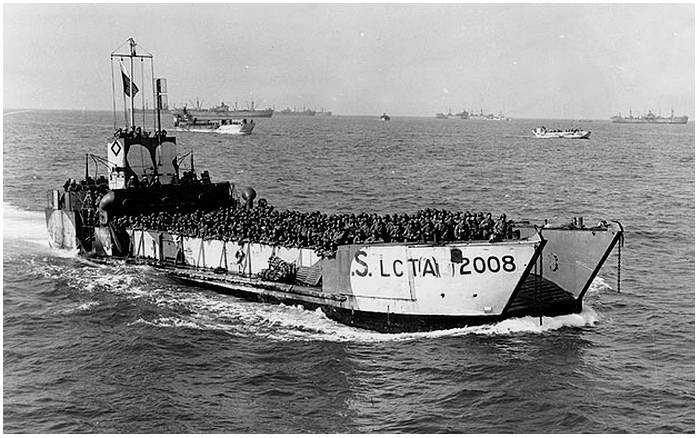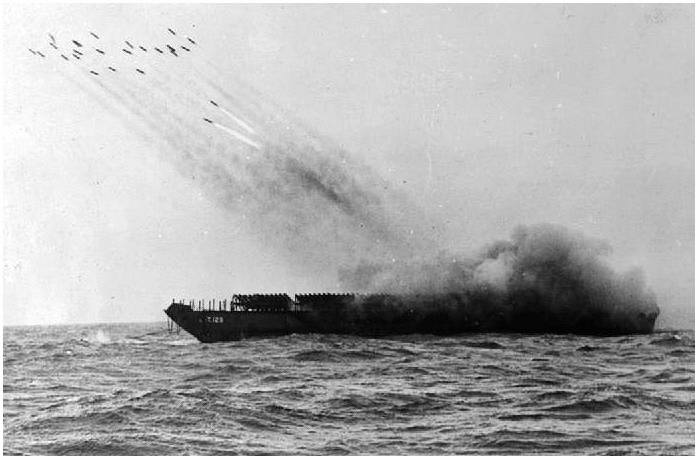The LST, LCT and
LCI

A Landing Ship, Tank (LST)
and a couple of LCVP's fighting the waves
Preface
The transport of men over water is centuries old. But it is
only since the forty's of the last century that the attacker
saw the great advance in putting men and cargo, when the
harbours were not usable, on beaches. This brought extra
concerns to the defender, not only the harbours needed
defences, but where to put strongholds on the sandy coast? The
thought to bring personnel and cargo to the beaches led to a
great assortment of flat bottomed landing craft. All with
their own speciality for an attack on a coast.

A Landing Craft, Tank (LCT) and LST-325
bringing tanks to shore
Below, you'll find a short summary of the different types
used during D-Day. Without these special landing craft there
was not a chance to bring an amphibious landing to a success,
let alone to start one.
Landing Ship, Tank
(LST)

Machinery comes out the bowls of a Landing Ship, Tank (LST)
When at the end of 1940 the threat of an invasion of
England by the Germans diminished, the British came up with
plans to built a fleet of landing craft. With these plans a
team left for the United States to request under the
'Lend-Lease' that they could built a Landing Ship Tank (LST)
and a Landing Craft Tank (LCT). From every type the British
ordered 200. At first the American were not that keen, but
eventually they would not only built LST's for the British,
but ordered also for there own inventory. The design of the
British was the basis for John Niedermair of the Bureau of
Ships, who started redesigning in November 1941. The proposed
ballast system was redesigned. When the LST was at sea it took
in seawater for more stability and when it was on landing
operations the tanks were emptied to create a flat bottomed
craft.

A British Sherman tank
leaves an American LST
The British produced 20 LST's. These were a bit longer
then the American version, and were steam driven. These gave
the LST a speed of 13 knots, against the 11 knots of the
American version which had diesel engines. The ships were,
because of their shallow depth, slow and cumbersome to handle.
They were an easy target. The crew who sailed these vessels
called the LST, the 'Long Slow Target'. America built 1051
LST's, 113 of these went to the British.

Ex-USS-LST 755 until 2010 in operation with
China as ROC Chung Hai LST 201
(notice the LCVP landingcraft)
The Landing Ship Tank was designed especially for unloading
large quantities of vehicles and cargo directly on the
beaches. When the LST hit the beach the two vertical bay doors
opened up so unloading could begin at once. In the davits was
place for the light attack landing craft, like the LCVP (see above). On deck
was plenty of room for a Landing Craft Tank (LCT) to be placed
on, and light vehicles. Below deck was space for 20 Sherman
tanks. The first LST's were equipped with a lift that brought
the vehicles from the upper deck to the lower decks. Later
models used a internal ramp that went directly to the bow for
unloading the cargo from the upper deck.

LCT 971 on board of LST 731
Landing Craft, Tank
(LCT)
The Landing Craft Tank (LCT) was also a landing craft
designed by the British and was perfected by the Americans. As
the name suggests, it was intended at first to transport 5 or
6 tanks to the beach.

LCT's during exercises on the English coast
These landing craft were responsible for the unloading of
the DD-tanks during D-Day. In rough sea some lost their ramp
doors, this was then towed behind the LCT. The LCT was
produced in several versions. The type most used during
'Operation Neptune', on 6th June, 1944, was the Mk IV and the
Mk V. Almost a dozen were lost that day during the landings.

A Centaur 95mm
near Hermanvill-sur-Mer,
the traverse graduation markings, for
lining the canon on board the LCT(A), are clearly visible.
One of the versions was the LCT(A), Armored. On board were
two Centaur 95mm howitzers and one Sherman 75mm who should
provide extra firepower during the landings. Unfortunately,
because of the wild movements at sea these LCT's were not able
to bring accurate fire on the targets. So the tanks on board
were brought to shore and went on fighting from there on. On
D-Day three LCT(A) were lost.

LCT(A) 2008 brings
more American GI's to Normandy on 7 June, 1944,
notice the
missing ramp! (lost during D-Day)
Another version was the LCT(R), these were supplied with
rockets, that brought a barrage of firepower. For this variant
an Mk III was adapted with 1066 launching tubes that gave
salvo's of 24 when fired. During D-Day 36 LCT(R) were
deployed.

An LCT(R) fires it rockets
From the Mk I till the Mk V, a total of 1569 were built, of
which 731 Mk IV's were produced, and 500 Mk V's.
Landing Craft,
Infantry (LCI)

LCI(L) 191 during a testrun in a harbour
The Landing Craft Infantry was an attack ship in the second
line of assault. When the first wave of men from the landing
boats, like the LCA's and LCVP's, had secured the beach, then
the reinforcements in big numbers was essential. For this
purpose the LCI was developed. The ship could hold 150 to 200
men. Those left the ship by the on both sides placed debarking
ramps.

The men disembark
LCI(L) 299 on the beach of Bernières-sur-Mer
As many pictures show, the LCI's were deployed in de early
hours in the British and Canadian sectors. The Canadian Royal
Navy used 30 LCI's on 6 June, 1944 in 10 flotilla which
brought 4600 men to the Normandy coast.

Two LCI's at rest on the beach
The LCI may not get the price for most 'flashy' assault
boat during the landings. This was mainly due to the fact of
the sideways placed debarking ramps. It was some sight to see
the men stumble of these ships, some with bikes on their
backs. Because it lacked a bow ramp, it was impossible to
'storm' from this landing craft. Some later models got a bow
door. In the American Navy the LCI was known as the 'Waterbug
Navy'. It got its nickname after an Admiral saw these craft
from the bridge of his battleship towering over the LCI's, it
reminded him of waterbugs. But these 'waterbugs' brought in a
short span of time and under enemy fire an enormous quantity
of men to shore.

An LCI with, at the front, a DUKW
from the 1st Armored Division
These craft were not only used for debarking soldiers. The
LCI was, just as the LCT, used in different versions. There
was an LCI(Demolition) which deployed divers to remove
underwater obstacles and on the beaches. The LCI(Gun) had 40mm
and 20mm canons and rockets for close support fire for the
troops who went on shore. The LCI(R) was equipped with
rockets. These were produced in several versions, one could,
for example, fire 600 rockets. The LCI(M) was a version
specially built to fire mortars.

LCI(G) 67 on the dry beach of
Okinawa after a tyfoon
The LCI was produced in America and had two rows of four
General Motors, 6 cylinder diesel engines. These could produce
3600 hp. The LCI with its flat bottom was not designed to
cross large masses of water. But the war decided differently,
speed was essential, so the LCI crossed the Atlantic Ocean
from America to England and even the Pacific to Asia. With
it's 48 meters it 'pretended' to act as a seaworthy vessel and
crossed the English Channel, loaded with infantry. The LCI
rolled unsteady in the waves and many soldiers and crew
donated their meals to Neptune.
For the next pages on
landing craft,
the LCA, LCVP, LCM, DUKW and LVT,
click: here
or on the LCVP's below.
|